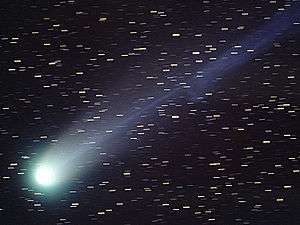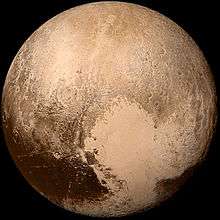1995 SN55
| Discovery | |
|---|---|
| Discovered by | A. Gleason |
| Discovery date | September 20, 1995 |
| Designations | |
| MPC designation | 1995 SN55 |
| Centaur[1][2] | |
| Orbital characteristics[1][3] | |
| Epoch 7 October 1995 (JD 2449997.5) | |
| Uncertainty parameter 9 | |
| Aphelion | 39.190 AU (5.8627 Tm) (Q) |
| Perihelion | 7.9400 AU (1.18781 Tm) (q) |
| 23.565 AU (3.5253 Tm) (a) | |
| Eccentricity | 0.66306 (e) |
| 114.39 yr (41782.5 d) | |
| 180.36° (M) | |
| 0.0086160°/day (n) | |
| Inclination | 4.9724° (i) |
| 144.61° (Ω) | |
| 49.332° (ω) | |
| Earth MOID | 6.94399 AU (1.038806 Tm) |
| Jupiter MOID | 2.49845 AU (373.763 Gm) |
| Physical characteristics | |
| Dimensions |
295 km?[4] 276 km[5] |
| 0.08 (assumed)[4][6][7] | |
| 6.0[1] | |
|
| |
1995 SN55, also written as 1995 SN55, is a lost centaur with a perihelion greater than Jupiter and a semi-major axis that may be less than Neptune's. This object could be the largest known centaur.
Size
If confirmed to be a centaur, 1995 SN55 would be one of the largest centaurs known. Centaurs typically have an albedo of about 0.08.[6][7] With an absolute magnitude (H) of 6.0,[1] and using an average centaur albedo of 0.08,[6][7] 1995 SN55 could be 295 km in diameter. The two largest known centaurs are 10199 Chariklo (250 km, H=7.40, albedo = 0.035) and 2060 Chiron (220 km, H=6.2, albedo = 0.07).
Loss
1995 SN55 was about 39 AU from the Sun when it was discovered. It was only observed 14 times over 36 days from September 20, 1995 until October 26 the same year.[1][3] Due to this short observation arc, the object has a very poorly known orbit and is considered lost. (See Lost comet or Lost asteroid.)
JPL shows this object having an aphelion distance of only 39.1 AU,[1] whereas the Deep Ecliptic Survey (DES) shows it having an aphelion distance of 91 AU.[3]
References
- 1 2 3 4 5 6 "JPL Small-Body Database Browser: (1995 SN55)" (last observation: 1995-10-26; arc: 36 days and lost). Retrieved 29 March 2016.
- ↑ "List Of Centaurs and Scattered-Disk Objects". Minor Planet Center. Retrieved 2008-10-21.
- 1 2 3 Marc W. Buie (1995-10-26). "Orbit Fit and Astrometric record for 95SN55". SwRI (Space Science Department). Retrieved 2008-10-21.
- 1 2 assumed to have a typical centaur albedo of 0.08
- ↑ Michael E. Brown. "How many dwarf planets are there in the outer solar system? (updates daily)". California Institute of Technology. Archived from the original on 2011-10-18. Retrieved 2014-03-26.
- 1 2 3 Wm. Robert Johnston (2008-09-17). "TNO/Centaur diameters and albedos". Johnston's Archive. Archived from the original on 22 October 2008. Retrieved 2008-10-21.
- 1 2 3 Bauer, James M.; Grav, Tommy; Blauvelt, Erin; Mainzer, Amy (2013). "Centaurs and Scattered Disk Objects in the Thermal Infrared: Analysis of WISE/NEOWISE Observations". The Astronomical Journal. 773 (1). arXiv:1306.1862
 . Bibcode:2013DPS....4550806B. doi:10.1088/0004-637X/773/1/22.
. Bibcode:2013DPS....4550806B. doi:10.1088/0004-637X/773/1/22.
External links
- Orbital simulation from JPL (Java) / Ephemeris
- 1995 SN55 at the JPL Small-Body Database



_(cropped).jpg)
